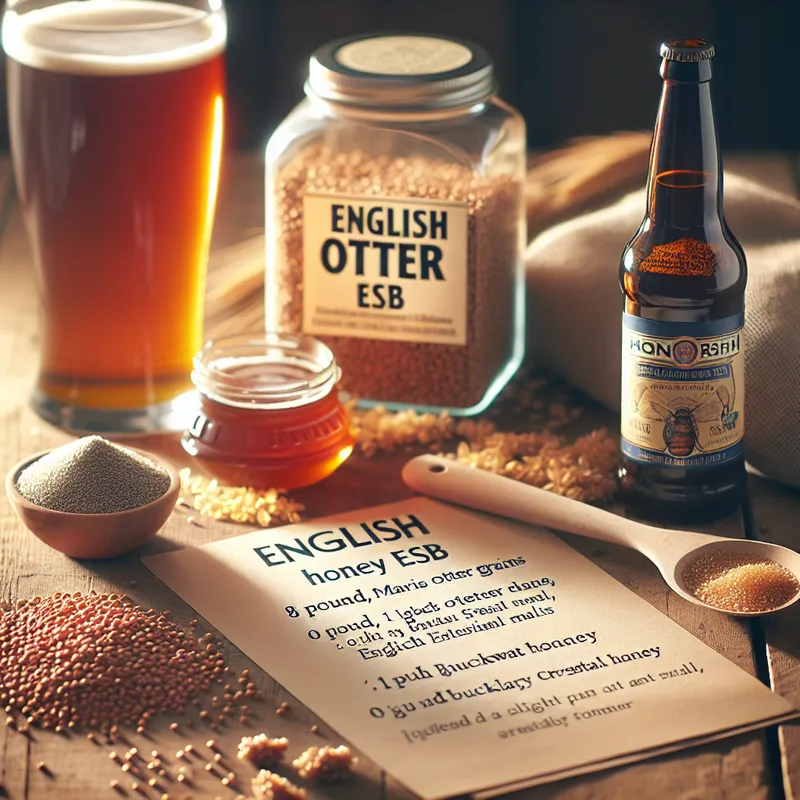English Honey ESB

" Altbier Honey Ale … Buckwheat, absolutebeer.com, Adapted for MPMW …, Adapted from …, Ale, Altbier Honey Ale, Beer | Ale | Braggot | Ale Mead Recipes by Name, Extract & Honey & Steeping Grain, Honey, Mead Recipe Tin by Name, MPMW Recipes by Name Source: Adapted for MPMW from absolutebeer.com INGREDIENTS 8 pounds (3.6 kg) of Maris Otter 0.5 pounds (227 g) each of light and dark English crystal (approximately 15L and 90L) 1 pound (454 g) of medium English crystal (45L) 1 pound (454 g) of Monarch Buckwheat honey DESCRIPTION No, not a braggot. With spring in the air and the bees waiting to get to work, Josh Weikert breaks out this ESB that uses honey as an adjunct sugar. Necessity is the mother of invention, or so I’m told. One fine spring, our homebrew club (the Stoney Creek Homebrewers) held a competition to see who could make the best honey beer—not a braggot, mind you, but a beer that used honey as an adjunct sugar. The result was a surprising array of beers that highlighted just how much value brewers can get out of just a bit of honey. This isn’t your grandpa’s honey—today’s honey has flavors that are wide ranging, perfectly complementary to malt (and even hops), and available (thanks to the growing popularity of mead) in an every-expanding universe of varieties. My entry into that competition (which, if memory serves, finished in third place) was a honey ESB, and with spring in the air and the bees waiting to get to work, it seemed like a great time to break it out. Style
In the strictest sense of the word, honey ales don’t have a “style.” In the 2015 BJCP Style Guidelines, they would probably best fall into category 31B, “Alternative Sugar Beer,” assuming that honey is the only specialty ingredient being used. In that style, the sugar’s character should be “evident,” but the underlying beer style should still be guiding the flavor profile. So, let’s assume we’re making an English Strong Bitter, but with a nice dose of complementary honey flavor! Spoiler Alert: this beer uses buckwheat honey, so it’s darker than most strong bitters. If you enter it in competition, consider tweaking the sub-style to something like a Mild (to account for it’s brown hue), or stress very hard in your description for the judges that buckwheat is a dark honey. DIRECTIONS We start with about eight pounds (3.6 kg) of Maris Otter to lay down that nice English biscuit base, but right away we need to keep in mind that honey is 100 percent fermentable, and so we’ll need to backstop the body by adding more than the usual amount of unfermentables. You can also address this in the mash, but I prefer to handle it “in house” in the grist, both to preserve my process and to get a more predictable result (and who doesn’t like the opportunity to add more English crystal malt to a recipe?). So rather than the usual pound of crystal, I double that: a half-pound (227 g) each of light and dark English crystal (approximately 15L and 90L) and an even pound (454 g) of medium English crystal (45L). That will give us plenty of great cracker-and-toffee character and add some heft. To that grist, we add just one pound (454 g) of buckwheat honey. It’s strong, so don’t overdo it. It’s like English candi syrup: earthy and treacly and slightly spicy, which is a wonderful complement to the style. It’s noticeable, for sure, but doesn’t fight the flavors that are already present."
Ratings (N/A)
login to submit a rating
A flavorful English Strong Bitter brewed with buckwheat honey for a unique twist. The combination of Maris Otter, English crystal malts, and earthy honey creates a rich and slightly spicy brew perfect for spring sipping.
ingredients
- 8 pounds Maris Otter
- 0.5 pounds each of light and dark English crystal
- 1 pound medium English crystal
- 1 pound Monarch Buckwheat honey
steps
- 1.
Mash the grains at 152°F for 60 minutes
- 2.
Sparge and bring to a boil
- 3.
Add buckwheat honey at flameout
- 4.
Chill, pitch yeast, and ferment at 68°F
- 5.
Bottle or keg when fermentation is complete
Releated Recipes
Comments
No comments yet.

